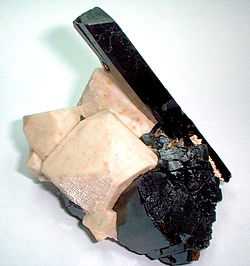Aegerine
| Aegirine | |
|---|---|

Monoclinic crystal of aegirine with orthoclase, from Mount Malosa, Zomba District, Malawi (size: 85 mm x 83 mm; 235 g)
|
|
| General | |
| Category | Silicate mineral, Pyroxene |
|
Formula (repeating unit) |
NaFe3+[ Si2O6] |
| Strunz classification | 9.DA.25 |
| Crystal system | Monoclinic |
| Crystal class | Prismatic (2/m) (same H-M symbol) |
| Space group | C2/c |
| Unit cell | a = 9.658, b = 8.795 c = 5.294 [Å], β = 107.42°; Z = 4 |
| Identification | |
| Formula mass | 231.00 g/mol |
| Color | Dark Green, Greenish Black |
| Crystal habit | Prismatic crystals may be in sprays of acicular crystals, fibrous, in radial concretions |
| Twinning | Simple and lamellar twinning common on {100} |
| Cleavage | Good on {110}, (110) ^ (110) ≈87°; parting on {100} |
| Fracture | Uneven |
| Tenacity | Brittle |
| Mohs scale hardness | 6 |
| Luster | Vitreous to slightly resinous |
| Streak | Yellowish-grey |
| Diaphaneity | Translucent to opaque |
| Specific gravity | 3.50 - 3.60 |
| Optical properties | Biaxial (-) |
| Refractive index | nα = 1.720 - 1.778 nβ = 1.740 - 1.819 nγ = 1.757 - 1.839 |
| Birefringence | δ = 0.037 - 0.061 |
| Pleochroism | X = emerald green, deep green; Y = grass-green, deep green, yellow; Z = brownish green, green, yellowish brown, yellow |
| 2V angle | Measured: 60° to 90°, Calculated: 68° to 84° |
| Dispersion | moderate to strong r > v |
| References | |
Aegirine is a member of the clinopyroxene group of inosilicates. Aegirine is the sodium endmember of the aegirine-augite series. Aegirine has the chemical formula NaFeSi2O6 in which the iron is present as Fe3+. In the aegirine-augite series the sodium is variably replaced by calcium with iron(II) and magnesium replacing the iron(III) to balance the charge. Aluminium also substitutes for the iron(III). It is also known as acmite, which is a fibrous, green-colored variety.
Aegirine occurs as dark green monoclinic prismatic crystals. It has a glassy luster and perfect cleavage. The Mohs hardness varies from 5 to 6 and the specific gravity is 3.2 to 3.4.
Commonly occurs in alkalic igneous rocks, nepheline syenites, carbonatites and pegmatites. Also in regionally metamorphosed schists, gneisses, and iron formations; in blueschist facies rocks, and from sodium metasomatism in granulites. It may occur as an authigenic mineral in shales and marls. It occurs in association with potassic feldspar, nepheline, riebeckite, arfvedsonite, aenigmatite, astrophyllite, catapleiite, eudialyte, serandite and apophyllite.
...
Wikipedia
